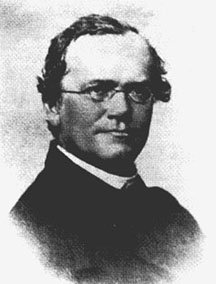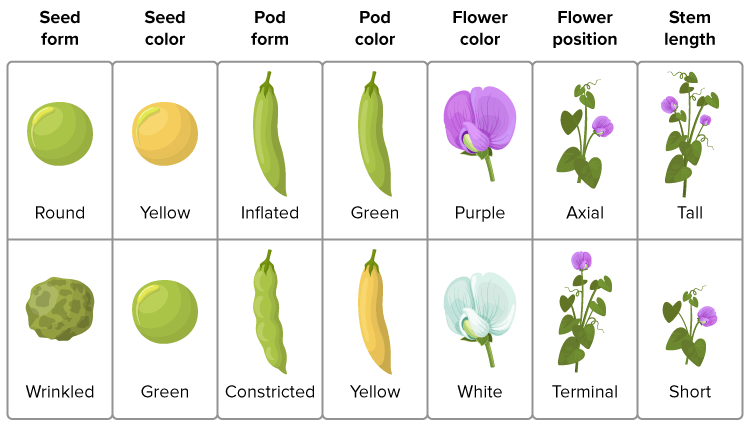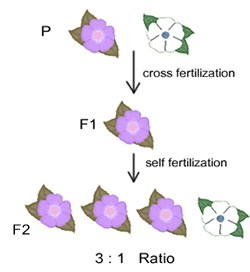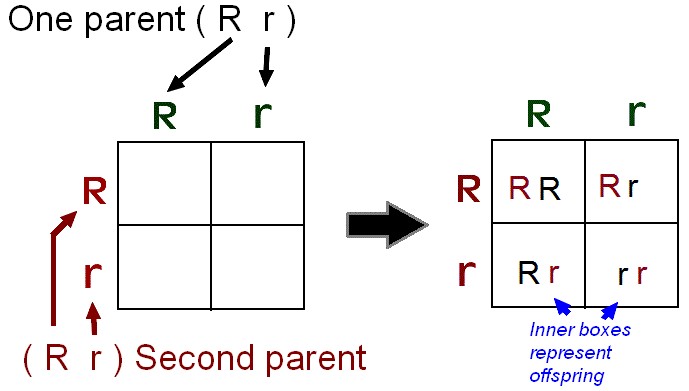
Mendel & Genetics (Bio 2)
Gregor Mendel: "father of genetics"
Genetics - the study of heredity
Heredity - the passing of traits from parents to offspring
Blending Theory
of Inheritance - offspring of two parents "blend" the traits
of both parents
Particulate Theory of Inheritance - traits are inherited as "particles",
offspring receive a "particle" from each parent.
Mendel's Experiments
Mendel chose pea plants as his experimental subjects, mainly because they were easy to cross and showed a variety of contrasting traits (purple vs white flowers, tall vs short stems, round vs wrinkled seeds)
Pea plants could be self fertilized or cross fertilized.
Example: A round seeded plant could fertilize itself or be crossed with a wrinkle-seeded plant.

Mendel's Plant Traits - CK12 (Ch 3.1)
1. Mendel chose true-breeding lines of each plant/trait he studied (true breeding lines always produced offspring of the same type)
2. He crossed a true breeding plant with a plant of the opposite trait (purple x white). He called this the Parental (P) generation. (In this case, he cross-pollinated the plants)
3. He recorded data on the offspring of this cross (First Filial, F1)
4. He self pollinated the F1 offspring
5. He recorded data on the offspring of the second generation, calling it the Second Filial generation (F2)
Analysis:
- The F1 generation always displayed one trait (he later called this the dominant trait)
- The F1 generation must have within it the trait from the original parents - the white trait
- The F2 generation displayed the hidden trait, 1/4 of the F2 generation had it (he later called this hidden trait the recessive trait)
- Each individual has two "factors" that determine what external appearance the offspring will have. (We now call these factors genes or alleles)

Mendel established three principles (or Laws) from his research
1. The Principle of Dominance and Recessiveness - one trait is masked or covered up by another trait
2. Principle of Segregation - the two factors (alleles) for a trait separate during gamete formation
3. Principle of Independent Assortment - factors of a trait separate independently of one another during gamete formation; another way to look at this is, whether a flower is purple has nothing to do with the length of the plants stems - each trait is independently inherited
Modern Genetics
Mendel's factors are now called ALLELES. For every trait a person have, two alleles determine how that trait is expressed.
We use letters to denote alleles, since every gene has two alleles, all genes can be represented by a pair of letters.
PP = purple, Pp = purple, pp = white
Homozogyous: when the alleles are the same, the individual is said to be homozygous, or true breeding. Letters designating a homozgyous individual could be capital or lowercase, as long as they are the same. Ex. AA, bb, EE, dd
Heterozygous: when the alleles are different, in this case the DOMINANT allele is expressed. Ex. Pp, Aa
Monohybrid cross = a cross involving one pair of contrasting traits. Ex. Pp x Pp
Punnet Square: used to determine the PROBABILITY of having a certain type of offspring given the alleles of the parents
Genotype: letters
used to denote alleles (BB, Pp..etc)
Phenotype: what an organism looks like (brown, purple..)
How to Use Punnett Squares to Determine Probability
In pea plants, round seeds are dominant to wrinkled.
Assign genotypes:
RR = round
R r = round
r r = wrinkled
If two heterozygous plants are crossed (R r x R r ), set up the square as shown below.

In this case 25% of the offspring will be wrinkled, and 75 % will be red.
Additional Resources
Performing Crosses with Two Traits
Simple Genetics Practice – using mendelian genetics and Punnett squares
Peas, Please – practice setting up squares for basic Mendelian traits in pea plants
Bunny Genetic Crosses with two traits – basic crosses, uses Punnett squares
Practice Punnett Squares with Skinny Pigs – hairless guinea pigs are the result of a recessive gene (Key, TpT)